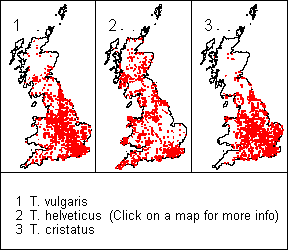
TRITURUS SPECIES IN THE UK

Three species of Triturus occur in the United Kingdom, T. cristatus, the Crested Newt, T. helveticus, the Palmate Newt, and T. vulgaris, the Smooth Newt. The maps above, based on data sent to the Biological Records Centre by volunteer recorders, show the general distribution of these three species in the UK. The smooth newt is the most common and widespread of the three species, and can be found over much of the UK, and also in Ireland, where it is the only native newt. The palmate newt was once thought to be an upland species, but it is now thought that water chemistry may play a part in determining habitat suitability for this species- it is more common in soft water areas. The crested newt, although widespread over the British mainland, is in decline, and is a protected species. This species favours larger water-bodies than the other two species. All three species are currently at risk from habitat loss; ponds are disappearing at an alarming rate.
IDENTIFICATION
Distinction between the crested newt and the smaller two species is simple. The crested newt is much larger (up to 15 cm, as opposed to a maximum of 10 cm for the other two species), has a warty rather than smooth skin, and usually has a yellow belly with large black spots. Eggs can also be easily distinguished from those of the smaller species. Crested newt eggs are somewhat larger, (the embryo size is about 2.5 mm; those of smooth and palmate newts are about 1.5 mm in diameter) and are pale yellow or white, as opposed to the brownish colour of the other two species. The larvae of crested newts can also be distinguished fairly easily, as they are substantially larger than palmate or smooth newt larvae at the same developmental stage.
Distinguishing the palmate and smooth newts is somewhat more problematic. Adult males in breeding condition are relatively dissimilar- the smooth newt has a high wavy crest, and a body with large spots, while the palmate newt has a very small crest, and a filament on the end of the tail, which is lacking in the smooth newt. Male palmate newts also have pronounced fleshy ridges along the edges of their back, which are entirely lacking in the smooth newt*.
Female smooth and palmate newts are extremely similar. The most reliable method for distinguishing the two is that female palmates have an unspotted throat, while that of smooth newts is almost always spotted. Juveniles of the smooth newt, however, also have unspotted throats. Larvae are impossible to distinguish in the field.
OTHER SPECIES
Escapes from captivity, as well as deliberate introductions, have resulted in several non-native newt species being established at a few locations in the wild. The most likely to be encountered in the field are the alpine newt, T. alpestris, and the Italian crested newt, T. carnifex.
The alpine newt is fairly easily distinguished from the native species, as adults of both sexes have a plain yellow to red belly, with no markings of any sort (although the throat may be spotted). The male has a low black and white spotted crest in the breeding season. The skin of both sexes is granular rather than smooth as in the two small native species, or warty in the crested newt. Colonies have been found in Shropshire, Berkshire, Surrey and Tyne and Wear. (Arnold, 1995, Banks, 1989, Wisniewski, 1989).
The Italian crested newt is somewhat more difficult to distinguish from the native northern crested newt; the most obvious difference is that juveniles and females have a yellow vertebral stripe. A colony of this species is known in Surrey.
Other species that may have been accidentally or purposefully introduced into the wild include the marbled newt, T. marmoratus, which, like the alpine and Italian crested newts, was formerly imported in the pet trade.
UK LAW
All the native species are protected, to varying degrees, by the Wildlife and Countryside Act, 1981. The smooth and palmate newts are protected only against unlicensed trade in wild-caught individuals, while the crested newt enjoys the maximum protection possible, being protected against intentional killing, capturing, possession, trade and disturbance. In addition, it is illegal to release any non-native species into the wild, including species previously naturalized. A maximum penalty of £2000 per animal can be levied if prosecution is brought.
* These distinguishing characters for the smooth newt apply to the subspecies T. vulgaris vulgaris, which is the only subspecies overlapping the range of the palmate newt. Other subspecies of the smooth newt, that are found elsewhere in Europe, may exhibit tail filaments and dorsolateral ridges, as well as having much reduced crests.
REFERENCES
Arnold, H. R., 1995. Atlas of the Amphibians and Reptiles in Britain. HMSO.
Banks, B., 1989. Alpine Newts in North East England. British Herpetological Society Bulletin 30: 4-5.
Wisniewski, P. J., 1989. Newts of
the British Isles. Shire, Aylesbury.
